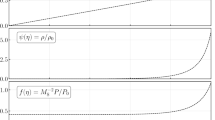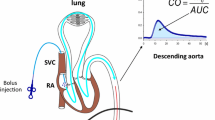Abstract
Various electrical-impedance methods have been proposed for the measurement of haemodynamic parameters noninvasively. For example, an impedance method is proposed for the measurement of cardiac output from the skin surface and is called impedance cardiography. However, there are many problems in the application of the impedance technique for the noninvasive measurement of haemodynamic parameters. One of them is the complicated structure of organs in the body. Another is the anomalous electrical properties of tissues. For these reasons, it is very difficult to obtain exact information about haemodynamics from the waveforms measured by the impedance cardiograph, in spite of the fact that the waveforms include much useful information. We can get useful information, if the relationships between the waveforms and the biomedical events in the subject are understood. In this paper, the relationships between the waveforms and the circulation of the blood are discussed theoretically and experimentally. The effects of the complicated structure of the organs and the anomalous electrical properties of tissues upon the waveforms are also discussed both theoretically and experimentally. For the analysis of the waveforms, it is very important to discuss (a) equipotential lines and potential distribution on the thorax, (b) the impedance or admittance between a pair of electrodes, (c) impedance or admittance changes due to blood circulation, (d) waveforms due to the pulsatile blood flow and (e) the effects of the complicated structure of organs upon the waveforms. From our results, it is concluded that:
-
(a)
the waveforms measured by an impedance cardiograph are affected not only by the change of blood volume in the aorta but also by that in various organs such as the heart and lungs.
-
(b)
the impedances measured by a pair of small electrodes separated by a short distance give useful information about the region in the vicinity of the electrodes
-
(c)
much valuable information will be available, if the relationships between the measurement results and the pulsatile blood flow are understood, and
-
(d)
by choosing an appropriate electrode arrangement, we may get much useful information about the blood circulation in the organs we want to investigate
Similar content being viewed by others
References
Kanai, H., Sakamoto, K. andMiki, M. (1976) Impedance of blood; the effects of red cell orientation. Proceedings of the 11th ICMBE, Ottawa, Canada, 238–239.
Sakamoto, K. andKanai, H. (1978) Electrical charac-teristics of flowing blood.Japan. J. MEBE,16, 45–52.
Edgerton, R. H. (1974) Conductivity of sheared suspensions of ellipsoidal particles with application to blood flow.IEEE Trans.,BME-21-1, 33–43.
Schwan, J. P. (1959) Alternating current spectroscopy of biological substances. Proceedings of theIRE, 10, 1845–1855.
Hill, D. W. andLowe, H. J. (1973) The use of the electrical-impedance technique for the monitoring of cardiac output and limb blood flow during anaesthesia.Med. & Biol. Eng.,11.
Geddes, L. A. andBaker, L. E. (1967) The specific resistance of biological material.Med. & Biol. Eng.,5, 271–293.
Author information
Authors and Affiliations
Rights and permissions
About this article
Cite this article
Sakamoto, K., Muto, K., Kanai, H. et al. Problems of impedance cardiography. Med. Biol. Eng. Comput. 17, 697–709 (1979). https://doi.org/10.1007/BF02441549
Received:
Accepted:
Issue Date:
DOI: https://doi.org/10.1007/BF02441549




